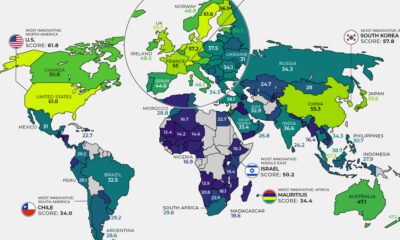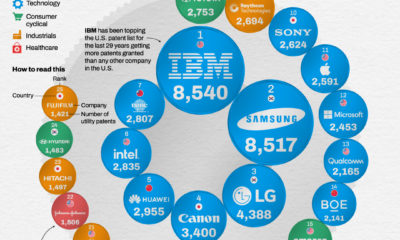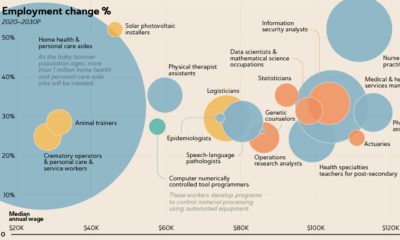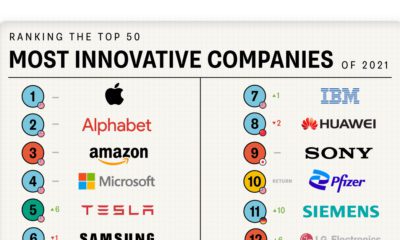This transformational device is a prototypical example of a technological breakthrough. It was a tipping point in turning entire business models upside-down, while also impacting our everyday lives at a more fundamental level. New growth opportunities emerged from the ensuing disruption, while many status quo solutions were rendered obsolete.
Technological Game-Changers
Today’s infographic from BlackRock highlights the pervasive and positive impact that technological breakthroughs can have on the global economy.
Fueling the Flames of Innovation
According to recent data from Accenture, it’s estimated that 71% of businesses are on the brink of being disrupted. In fact, disruptive innovation most often emerges in two scenarios:
New solutions to existing problems or challenges that have proven difficult to solve New competitors in highly profitable sectors with historically high returns
The occurrence of technological breakthroughs can also be accelerated through several factors, including significant demographic shifts, sustained economic growth, innovative political environments, and urgent societal needs.
Technological Adoption is Speeding Up
Breakthrough inventions have always sent ripple effects throughout society, but today those ripples are travelling faster than ever. Moore’s Law – the assertion that number of components in a dense integrated circuit (i.e., transistors, resistors, diodes, or capacitors) will double every year, while still getting cheaper – is one factor. Similar examples of staggering increases in utility for less cost can be found in a number of other instances, from DNA sequencing to data storage. The rate of technological adoption is also speeding up. For example, consider the mobile phone─due to the price point and ease of use, the number of U.S. adults with a cell phone jumped from 10% in 1994 to over 96% in 2019. This is also evident in new technologies such as smart speakers, where the adoption rate in the U.S. is expected to double to 55% in less than 3 years.
Breakthrough Investment Opportunities
Where innovation leads, investment usually follows. However, predicting which technological innovations will have a lasting impact on society has often proved difficult. Instead, investors can track the wider trends that often spark technological disruption, in order to unlock potential opportunities:
Future Impact of Technological Innovation
Technological change will likely continue to accelerate, and investors should tailor their portfolios accordingly. At the same time, traditional barriers to entry for new competitors are consistently being eroded by these breakthroughs, sending industries into flux and creating potential new opportunities. Humanity’s co-evolution with technology will continue to profoundly impact the economy, while improving life on Earth in unimaginable ways. on But fast forward to the end of last week, and SVB was shuttered by regulators after a panic-induced bank run. So, how exactly did this happen? We dig in below.
Road to a Bank Run
SVB and its customers generally thrived during the low interest rate era, but as rates rose, SVB found itself more exposed to risk than a typical bank. Even so, at the end of 2022, the bank’s balance sheet showed no cause for alarm.
As well, the bank was viewed positively in a number of places. Most Wall Street analyst ratings were overwhelmingly positive on the bank’s stock, and Forbes had just added the bank to its Financial All-Stars list. Outward signs of trouble emerged on Wednesday, March 8th, when SVB surprised investors with news that the bank needed to raise more than $2 billion to shore up its balance sheet. The reaction from prominent venture capitalists was not positive, with Coatue Management, Union Square Ventures, and Peter Thiel’s Founders Fund moving to limit exposure to the 40-year-old bank. The influence of these firms is believed to have added fuel to the fire, and a bank run ensued. Also influencing decision making was the fact that SVB had the highest percentage of uninsured domestic deposits of all big banks. These totaled nearly $152 billion, or about 97% of all deposits. By the end of the day, customers had tried to withdraw $42 billion in deposits.
What Triggered the SVB Collapse?
While the collapse of SVB took place over the course of 44 hours, its roots trace back to the early pandemic years. In 2021, U.S. venture capital-backed companies raised a record $330 billion—double the amount seen in 2020. At the time, interest rates were at rock-bottom levels to help buoy the economy. Matt Levine sums up the situation well: “When interest rates are low everywhere, a dollar in 20 years is about as good as a dollar today, so a startup whose business model is “we will lose money for a decade building artificial intelligence, and then rake in lots of money in the far future” sounds pretty good. When interest rates are higher, a dollar today is better than a dollar tomorrow, so investors want cash flows. When interest rates were low for a long time, and suddenly become high, all the money that was rushing to your customers is suddenly cut off.” Source: Pitchbook Why is this important? During this time, SVB received billions of dollars from these venture-backed clients. In one year alone, their deposits increased 100%. They took these funds and invested them in longer-term bonds. As a result, this created a dangerous trap as the company expected rates would remain low. During this time, SVB invested in bonds at the top of the market. As interest rates rose higher and bond prices declined, SVB started taking major losses on their long-term bond holdings.
Losses Fueling a Liquidity Crunch
When SVB reported its fourth quarter results in early 2023, Moody’s Investor Service, a credit rating agency took notice. In early March, it said that SVB was at high risk for a downgrade due to its significant unrealized losses. In response, SVB looked to sell $2 billion of its investments at a loss to help boost liquidity for its struggling balance sheet. Soon, more hedge funds and venture investors realized SVB could be on thin ice. Depositors withdrew funds in droves, spurring a liquidity squeeze and prompting California regulators and the FDIC to step in and shut down the bank.
What Happens Now?
While much of SVB’s activity was focused on the tech sector, the bank’s shocking collapse has rattled a financial sector that is already on edge.
The four biggest U.S. banks lost a combined $52 billion the day before the SVB collapse. On Friday, other banking stocks saw double-digit drops, including Signature Bank (-23%), First Republic (-15%), and Silvergate Capital (-11%).
Source: Morningstar Direct. *Represents March 9 data, trading halted on March 10.
When the dust settles, it’s hard to predict the ripple effects that will emerge from this dramatic event. For investors, the Secretary of the Treasury Janet Yellen announced confidence in the banking system remaining resilient, noting that regulators have the proper tools in response to the issue.
But others have seen trouble brewing as far back as 2020 (or earlier) when commercial banking assets were skyrocketing and banks were buying bonds when rates were low.














